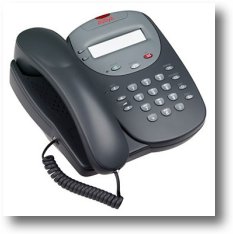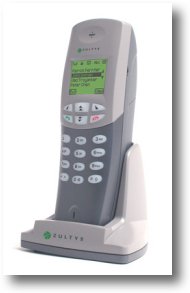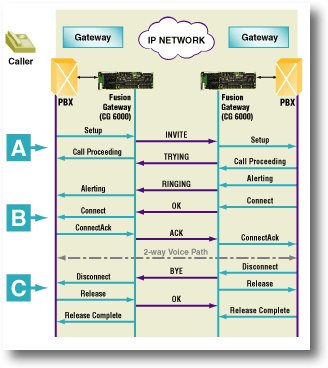sip, Sip, SIP - Gulp!
May 2007
 Session Initiation Protocol
or 'SIP' as it is known has become a major signalling protocol in the IP world as it lies at the heart of Voice-over-IP (VoIP). It's a term you can hardly miss as it is supported by
every vender of phones on the planet (Picture credit: Avaya: An Avaya SIP phone).
Session Initiation Protocol
or 'SIP' as it is known has become a major signalling protocol in the IP world as it lies at the heart of Voice-over-IP (VoIP). It's a term you can hardly miss as it is supported by
every vender of phones on the planet (Picture credit: Avaya: An Avaya SIP phone).
Many open software groups have taken SIP to the heart of their initiatives and an example of this is IP Multimedia Subsystem (IMS) which I recently touched upon in IP Multimedia Subsystem or bust!
SIP is a real-time IP applications layer protocol that sits alongside HTTP, FTP, RTP and other well known protocols used to move data through the Internet. However it is an extremely important one because it enables SIP devices to discover, negotiate, connect and establish communication sessions with other SIP enabled devices.
SIP was co-authored in 1996 by Jonathan Rosenberg who is now a Cisco Fellow, Henning Schulzrinne who is Professor and Chair in the Dept. of Computer Science at Columbia University and Mark Handley who is Professor of Networked Systems at UCL. SIP became an IETF SIP Working Group which is still supporting the RFC 3261 standard. SIP was originally used on the US experimental Multicast network commonly known as Mbone. This makes SIP an IT /IP standard rather than one developed by the communications industry.
Prior to SIP, voice signalling protocols were essentially proprietary signalling protocols aimed at use by the big telecommunications companies on their big Public Switched Telecommunications Networks (PSTN) voice networks such as SS7 (C7 in the UK). With the advent of the Internet and the 'invention' of Voice over IP, it soon became clear that a new signalling protocol was required that was peer-to-peer, scalable, open, extensible, lightweight and simple in operation that could be used on a whole new generation of real-time communications devices and services that are running over the Internet.
SIP itself is based on earlier IETF / Internet standards, principally Hypertext Transport Protocol (HTTP) which is the core protocol behind the World Wide Web.
Key features of SIP
The SIP signalling standard has many key features:
Communications device identification: SIP supports a concept known as Address of Record (AOR) which represents a user's unique address in the world of SIP communications. An example of an AOR is sip: [email protected]. To enable a user to have multiple communications devices or services, SIP has a mechanism called a Uniform resource Identifier (URI). A URI is like the Uniform Resource Locator (URL) used to identify servers on the world wide web. URIs can be used to specify the destination device of a real-time session e.g.
-
IM: sip: [email protected] (Windows Messenger uses SIP)
-
Phone: sip: 1234 1234 [email protected]; user=phone
-
FAX: sip: 1234 1234 [email protected]; user=fax
A SIP URI can use both traditional PSTN numbering schemes AND alphabetic schemes as used on the Internet.
Focussed function: SIP only manages the set up and tear down of real time communication sessions, it does not manage the actual transport of media data. Other protocols undertake this task.
 Presence support: SIP is used in a
variety of applications but has found a strong home in applications such as VoIP and Instant Messaging (IM). What makes SIP interesting is that it is not only capable of setting up and tearing
down real time communications sessions but also supports and tracks a user's availability through the Presence capability. The open presence standard
Jabber uses SIP. I wrote about presence in -
The magic of �presence�.
Presence support: SIP is used in a
variety of applications but has found a strong home in applications such as VoIP and Instant Messaging (IM). What makes SIP interesting is that it is not only capable of setting up and tearing
down real time communications sessions but also supports and tracks a user's availability through the Presence capability. The open presence standard
Jabber uses SIP. I wrote about presence in -
The magic of �presence�.
Presence is supported through a key SIP extension: SIP for Instant messaging and Presence Leveraging Extensions (SIMPLE) [a really contrived acronym!]. This allows a user to state their status as seen in most of the common IM systems. AOL Instant Messenger is shown in the picture on the left.
SIMPLE means that the concept of Presence can be used transparently on other communications devices such as mobile phones, SIP phones, email clients and PBX systems.
User preference: SIP user preference functionality enables a user to control how a call is handled in accordance to their preferences. For example:
-
Time of day: A user can take all calls during office hours but direct them to a voice mail box in the evenings.
-
Buddy lists: Give priority to certain individuals according to a status associated with each contact in an address book.
-
Multi-device management: Determine which device / service is used to respond to a call from particular individuals.
PSTN mapping: SIP can manage the translation or mapping of conventional PSTN numbers to SIP URIs and vice versa. This capability allows SIP sessions to transparently inter-work with the PSTN. There are organisations, such as ENUM, who provide appropriate database capabilities. To quote ENUM's home page:
"ENUM unifies traditional telephony and next-generation IP networks, and provides a critical framework for mapping and processing diverse network addresses. It transforms the telephone number�the most basic and commonly-used communications address�into a universal identifier that can be used across many different devices and applications (voice, fax, mobile, email, text messaging, location-based services and the Internet)."
SIP trunking: SIP trunks enable enterprises to group inter-site calls using a pure IP network. This could use an IP-VPN over an MPLS-based network with a guaranteed Quality of Service. Using SIP trunks could lead to significant cost saving when compared to using traditional E1 or T1 leased lines.
 Inter-island communications:
In a recent post,
Islands of communication or isolation? I wrote about the challenges of communication between islands of standards or users. The adoption of SIP-based services could enable a degree
of integration with other companies to extend the reach of what, to date, have been internal services.
Inter-island communications:
In a recent post,
Islands of communication or isolation? I wrote about the challenges of communication between islands of standards or users. The adoption of SIP-based services could enable a degree
of integration with other companies to extend the reach of what, to date, have been internal services.
Of course, the partner companies need to have adopted SIP as well and have appropriate security measures in place. This is where the challenge would lay in achieving this level of open communications! (Picture credit: Zultys: a Wi-Fi SIP phone)
SIP servers
SIP servers are the centralised capability that manage establishment of communications sessions by users. Although there are many types of server, they are essentially only software processes and could be run on a single processor or device. There are several types of SIP server:
Registrar Server: The registrar server authenticates and registers users as soon as they come on-line. It stores identities and the list of devices in use by each user.
Location Server: The location server keeps track of users' locations as they roam and provides this data to other SIP servers as required.
Redirect Server: When users are roaming, the Redirect Server maps session requests to a server closer to the user or an alternate device.
Proxy Server: SIP Proxy servers pass on SIP requests that are located either downstream or upstream.
Presence Server: SIP presence servers enable users to provide their status (presentities) to other users who would like to see it (Watchers).
Call setup Flow
The diagram below shows the initiation of a call from the PSTN network (section A), connection (section B) and disconnect (section C). The flow is quite easy to understand. One of the downsides is that if a complex session is being set up it's quite easy to get up to 40 to 50+ separate transactions which could lead to unacceptable set-up times being experienced - especially if the SIP session is being negotiated across the best-effort Internet.

(Picture source: NMS Communications)
Round-up
As a standard SIP has had a profound impact on our daily lives and lives well along those other protocol acronyms that have fallen into the daily vernacular such as IP, HTTP, www and TCP. Protocols that operate at the application level seem to be so much more relevant to our daily lives than those that are buried in the network such as MPLS and ATM.
There is still much to achieve by building capability on top of SIP such as federated services and more importantly interoperability. Bodies working on interoperability are SIPcenter, SIP Forum, SIPfoundry, SIP'it and IETF's SPEERMINT working group. More fundamental areas under evaluation are authentication and billing.
More depth information about SIP can be found at http://www.tech-invite.com, a portal devoted to SIP and surrounding technologies.
Next time you just buy a SIP Wi-Fi phone from your local shop, install it, find that it works first time AND saves you money, just think about all the work that has gone into creating this software wonder. Sometimes, standards and open software hit a home run. SIP is just that.
